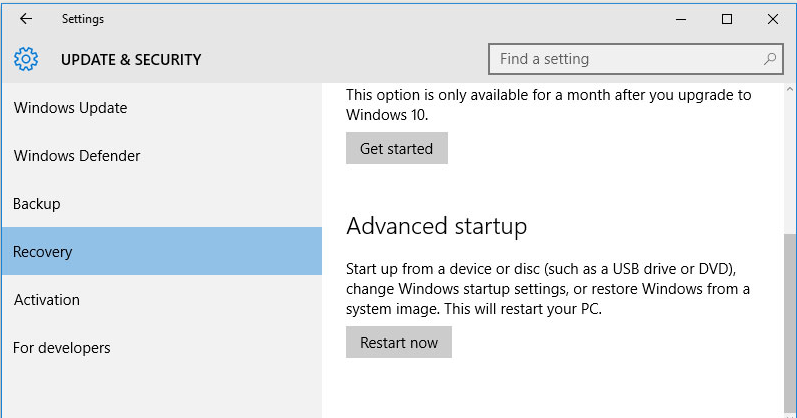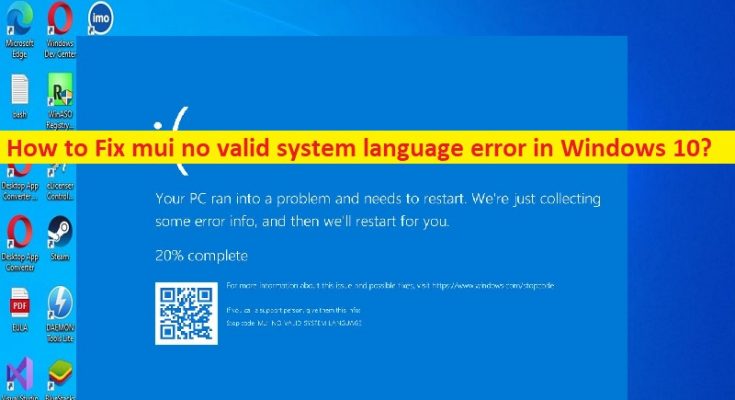Tips to fix MUI_NO_VALID_SYSTEM_LANGUAGE BSOD error in Windows 10:
In this post, we are going to discuss on How to fix MUI_NO_VALID_SYSTEM_LANGUAGE, mui no valid system language BSOD error in Windows 10.You will be guided with easy steps/methods to resolve the issue. Let’s starts the discussion.
‘MUI_NO_VALID_SYSTEM_LANGUAGE’ BSOD error: It is common Windows Problem considered as BSOD (Blue Screen of Death) error. This error is appeared usually in the middle of your work on computer or when you start/restart Windows 10 computer. This BSOD error is appeared with message saying ‘Your PC ran into a problem and needs to restart. We’re just collecting some error info, and then we’ll restart for you’ along with some Windows Stop Codes like MUI_NO_VALID_SYSTEM_LANGUAGE and 0x0000012A error.
There could be several reasons behind the issue including the corruption in system files or registry, malware or viruses infections in computer, malware or viruses infections in computer, corrupted/outdated BIOS, outdated Windows and device drivers, and other issues. You should make sure all device drivers are properly installed and are up-to-date to latest & compatible version and also make sure Windows OS is up-to-date in computer.
If not, device driver update is necessary in computer if you don’t want to face this type of issue. This issue can be occurred due to interference of third-party antivirus/firewall program in computer or other conflicting software installed or hardware attached into computer is interfering that’s why the error is occurred. It is possible to fix the issue with our instructions. Let’s go for the solution.
How to fix mui no valid system language BSOD error in Windows 10?
Method 1: Fix MUI_NO_VALID_SYSTEM_LANGUAGE BSOD error with ‘PC Repair Tool’
‘PC Repair Tool’ is easy & quick way to find and fix BSOD errors, DLL errors, EXE errors, problems with programs/applications, malware or viruses infections in computer, system files or registry issues, and other system issues with just few clicks.
Method 2: Start computer in Safe Mode

Before performing any steps toward resolving the issue, you need to turn ON your computer in safe mode so that you can perform all mentioned solutions without any problem.
Step 1: Open ‘Settings’ app in Windows PC via Windows Search Box and go to ‘Update & Security > Recovery > Advanced Startup’ and click ‘Restart Now’
Step 2: Select ‘Troubleshoot > Advanced Options > Startup Settings’
Step 3: Select ‘Enable Safe Mode’ and press ‘Restart’. After restart, choose ‘Enable Safe Mode’ by pressing ‘F4’ key to enter into Safe Mode.
Method 3: Update Device Drivers
Updating device drivers to latest & compatible version can resolve the issue.
Step 1: Open ‘Device Manager’ in Windows PC via Windows Search Box and look for device driver that is showing Yellow mark on it
Step 2: Right-click device driver that you want to update, and select ‘Update Driver’ and follow on-screen instructions to finish update process. Repeat the same process to finish update process for other drivers. Once updated, restart your computer and check if the issue is resolved.
Download or reinstall device drivers update in Windows PC [Automatically]
You can also try to update all Windows drivers including graphics card driver, sound card driver and other device drivers to latest & compatible version using Automatic Driver Update Tool. You can get this tool through button/link below.
Method 3: Run SFC scan and CHKDSK scan
You can run SFC scan and CHKDSK scan in computer to repair the corruption in system files and hard disk drives in order to fix the issue.
Step 1: Type ‘cmd’ in Windows Search Box and press ‘SHIFT + ENTER’ keys on keyboard to open ‘Command Prompt as Administrator’
Step 2: Type ‘sfc /scannow’ command and hit ‘Enter’ to execute.
Step 3: Once executed, execute ‘chkdsk c: /f’ command and after that, restart your computer and check if the issue is resolved.
Method 4: Use the mode of compatibility with old version of Windows

If the error is occurred after launching a program, then using Windows compatibility mode can resolve the issue.
Step 1: Find and right-click on executable (.exe) of program that is causing error and select ‘Troubleshoot compatibility’
Step 2: Follow on-screen instructions to finish program compatibility troubleshooter process and once finished, check if the issue is resolved.
Method 5: Disable unnecessary programs in Windows Startup menu
Step 1: Press ‘CTRL + SHIFT + ESC’ keys on keyboard to open ‘Task Manager’ app
Step 2: Click ‘Startup’ tab, right-click on each unnecessary startup item and select ‘Disable’ to disable it. Once done, restart your computer and check if it works.
Method 6: Update Windows OS

Updating Windows OS to latest version can resolve the issue.
Step 1: Open ‘Settings’ app in Windows PC via Windows Search Box and go to ‘Update & Security > Windows Update’ and click ‘Check for updates’ button
Step 2: Download and install all available updates in computer and once updated, restart your computer and check if the issue is resolved.
Method 7: Run Windows Memory Diagnostic tool
You can run Windows Memory Diagnostic Tool to scan and repair RAM and memory issue.
Step 1: Open ‘Windows Memory Diagnostic’ tool in Windows PC via Windows Search Box
Step 2: Select ‘Restart now and check for problems’ option and wait to finish the process. Once done, restart your computer and check if it works for you.
Method 8: Clean Windows 10 installation
If the issue is still persist, you can try to fix the issue by performing cleaning Windows 10 installation in computer. To do so, you need to insert bootable Windows 10 installation media USB to your computer and boot with it, and then perform on-screen instructions to finish installation. Once finished, check if the issue is resolved.
Conclusion
I am sure this post helped you on How to fix MUI_NO_VALID_SYSTEM_LANGUAGE, mui no valid system language BSOD error in Windows 10 with easy ways. You can read & follow our instructions to do so. That’s all. For any suggestions or queries, please write on comment box below.



